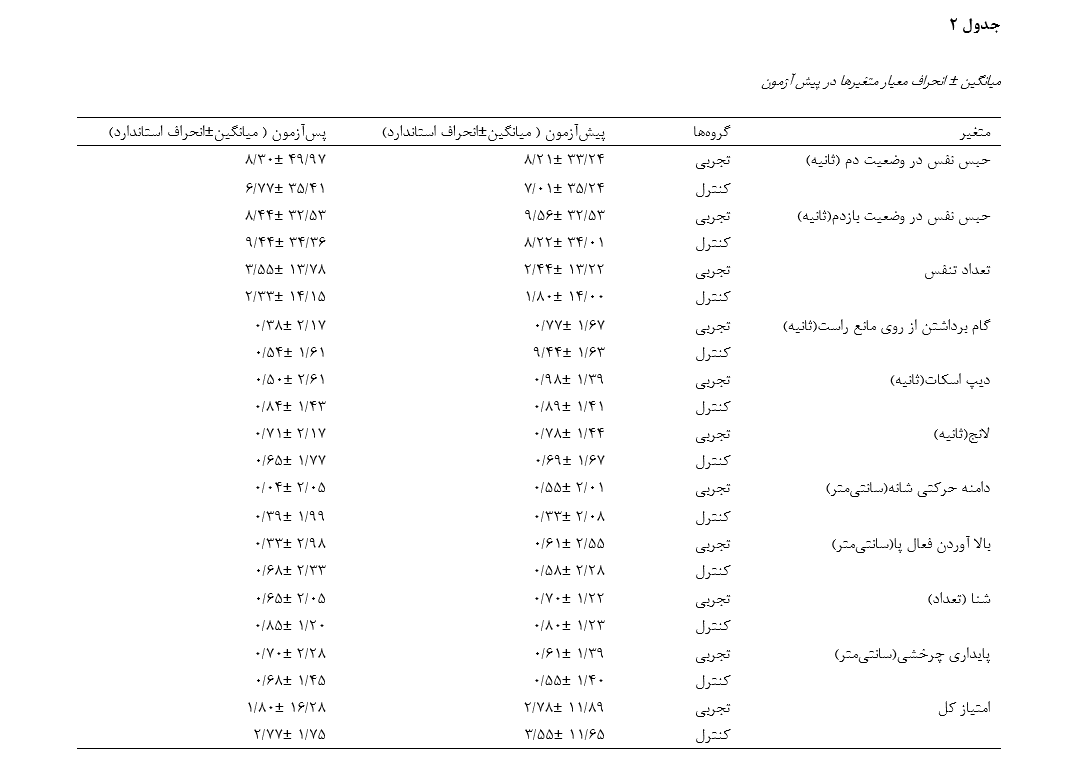تاثیر تمرینات ثبات عصبی-عضلانی پویا بر عملکرد تنفسی و کیفیت حرکت در زنان چاق
کلمات کلیدی:
ثبات عصبی-عضلانی پویا، چاقی، عملکرد تنفسی، کیفیت حرکت، سلامت زنان، مداخله تمرینیچکیده
هدف این مطالعه، بررسی اثر تمرینات ثبات عصبی-عضلانی پویا بر برخی شاخصهای عملکرد تنفسی و کیفیت حرکت در زنان دارای اضافهوزن و چاق بود. در این پژوهش نیمهتجربی، ۳۶ زن چاق با شاخص توده بدنی بیشتر از ۲۹ و در بازه سنی ۲۵ تا ۴۵ سال، بهصورت تصادفی در دو گروه آزمایشی (۱۸ نفر) و کنترل (۱۸ نفر) قرار گرفتند. گروه آزمایشی طی شش هفته، در سه جلسه تمرین ۴۵ تا ۶۰ دقیقهای در هفته شرکت کرد. عملکرد تنفسی با استفاده از آزمون حبس نفس (در دم و بازدم) و تعداد تنفس در دقیقه و کیفیت حرکت از طریق آزمون غربالگری حرکت عملکردی (FMS) ارزیابی شد. ارزیابیها پیش و پس از مداخله برای هر دو گروه انجام شد. تحلیل کوواریانس نشان داد که تمرینات ثبات عصبی-عضلانی پویا بر ظرفیت حبس نفس در دم و بازدم و برخی شاخصهای کیفیت حرکت مانند عبور از مانع، شنای سوئدی، ثبات چرخشی و نمره کل حرکت تأثیر معنادار آماری دارد (P<0.001). با این حال، تفاوت معناداری در تعداد تنفس، حرکت اسکات، لانج و دامنه حرکتی شانه بین دو گروه مشاهده نشد (P>0.05). یافتهها حاکی از آن است که تمرینات ثبات عصبی-عضلانی پویا میتواند در بهبود عملکرد تنفسی (خصوصاً ظرفیت حبس نفس) و برخی الگوهای حرکت عملکردی در زنان چاق مؤثر باشد. با توجه به محدودیت برخی متغیرها، مطالعات آینده با طراحی دقیقتر و ابزارهای ارزیابی پیشرفتهتر توصیه میشود.
مراجع
Blüher, M. (2019). Obesity: global epidemiology and pathogenesis. Nature Reviews Endocrinology, 15(5), 288-298. https://doi.org/https://doi.org/10.1038/s41574-019-0176-8
Butterworth, A. A., Landorf, K. B., Gilleard, W., Urquhart, D. M., & Menz, H. (2014). The association between body composition and foot structure and function: a systematic review. Obesity Reviews, 15(4), 348-357. https://doi.org/https://doi.org/10.1111/obr.12130
Chaitow, L., Bradley, D., & Gilbert, C. P. (2014). Recognizing and treating breathing disorders: a multidisciplinary approach. [No publisher].
Davidek, P., Andel, R., & Kobesova, A. (2018). Influence of dynamic neuromuscular stabilization approach on maximum kayak paddling force. Journal of Human Kinetics, 61, 15. https://doi.org/https://doi.org/10.1515/hukin-2017-0127
Frank, C., Kobesova, A., & Kolar, P. (2013). Dynamic neuromuscular stabilization & sports rehabilitation. International Journal of Sports Physical Therapy, 8(1), 62.
Freitas, P. D., Ferreira, P. G., Silva, A. G., Stelmach, R., Carvalho-Pinto, R. M., Fernandes, F. L., & et al. (2017). The role of exercise in a weight-loss program on clinical control in obese adults with asthma: A randomized controlled trial. American Journal of Respiratory and Critical Care Medicine, 195(1), 32-42. https://doi.org/https://doi.org/10.1164/rccm.201603-0446OC
Izraelski, J. (2012). Assessment and treatment of muscle imbalance: The Janda approach. The Journal of the Canadian Chiropractic Association, 56(2), 158.
Jung, J., Lee, J., Chung, E., & Kim, K. (2014). The effect of obstacle training in water on static balance of chronic stroke patients. Journal of Physical Therapy Science, 26(3), 437-440. https://doi.org/https://doi.org/10.1589/jpts.26.437
Kim, S. Y., Kang, M. H., Kim, E. R., Jung, I. G., Seo, E. Y., & Oh, J. S. (2016). Comparison of EMG activity on abdominal muscles during plank exercise with unilateral and bilateral additional isometric hip adduction. Journal of electromyography and kinesiology, 30, 9-14. https://doi.org/https://doi.org/10.1016/j.jelekin.2016.05.003
Kobesova, A., Dzvonik, J., Kolar, P., Sardina, A., & Andel, R. (2015). Effects of shoulder girdle dynamic stabilization exercise on hand muscle strength. Isokinetics and Exercise Science, 23(1), 21-32. https://doi.org/https://doi.org/10.3233/IES-140560
Kobesova, A., & Kolar, P. (2014). Developmental kinesiology: Three levels of motor control in the assessment and treatment of the motor system. Journal of bodywork and movement therapies, 18(1), 23-33. https://doi.org/https://doi.org/10.1016/j.jbmt.2013.04.002
Kolar, P., & Kobesova, A. (2010). Postural-locomotion function in the diagnosis and treatment of movement disorders. Clinical Chiropractic, 13(1), 58-68. https://doi.org/https://doi.org/10.1016/j.clch.2010.02.063
Littleton, S. W. (2012). Impact of obesity on respiratory function. Respirology, 17(1), 43-49. https://doi.org/https://doi.org/10.1111/j.1440-1843.2011.02096.x
Mafort, T. T., Rufino, R., Costa, C. H., & Lopes, A. J. (2016). Obesity: systemic and pulmonary complications, biochemical abnormalities, and impairment of lung function. Multidisciplinary Respiratory Medicine, 11, 1-11. https://doi.org/https://doi.org/10.1186/s40248-016-0066-z
Mahdieh, L., Zolaktaf, V., & Karimi, M. T. (2020). Effects of dynamic neuromuscular stabilization (DNS) training on functional movements. Human Movement Science, 70, 102568. https://doi.org/https://doi.org/10.1016/j.humov.2019.102568
Park, D. J., & Park, S. Y. (2019). Which trunk exercise most effectively activates abdominal muscles? A comparative study of plank and isometric bilateral leg raise exercises. Journal of Back and Musculoskeletal Rehabilitation, 32(5), 797-802. https://doi.org/https://doi.org/10.3233/BMR-181122
Park, S. Y., & Yoo, W. G. (2014). Effects of hand and knee positions on muscular activity during trunk extension exercise with the Roman chair. Journal of electromyography and kinesiology, 24(6), 972-976. https://doi.org/https://doi.org/10.1016/j.jelekin.2014.08.012
Pranoto, N. W., Anugrah, S., Fitriady, G., Setyawan, H., Adrian Geantă, V., Sibomana, A., & et al. (2024). The effectiveness of diet and exercise in the management of obesity. Retos: Nuevas Perspectivas de Educación Física, Deporte y Recreación, 58. https://doi.org/https://doi.org/10.47197/retos.v58.105295
Savulescu-Fiedler, I., Mihalcea, R., Dragosloveanu, S., Scheau, C., Baz, R. O., Caruntu, A., & et al. (2024). The interplay between obesity and inflammation. Life, 14(7), 856. https://doi.org/https://doi.org/10.3390/life14070856
Sharma, K., & Yadav, A. (2020). Dynamic neuromuscular stabilization-a narrative. International Journal of Health Sciences and Research, 10(9), 221-231.
Silveira, E. A., Mendonça, C. R., Delpino, F. M., Souza, G. V. E., de Souza Rosa, L. P., de Oliveira, C., & et al. (2022). Sedentary behavior, physical inactivity, abdominal obesity and obesity in adults and older adults: A systematic review and meta-analysis. Clinical Nutrition ESPEN, 50, 63-73. https://doi.org/https://doi.org/10.1016/j.clnesp.2022.06.001
Son, M. S., Jung, D. H., You, J. H., Yi, C. H., Jeon, H. S., & Cha, Y. J. (2017). Effects of dynamic neuromuscular stabilization on diaphragm movement, postural control, balance and gait performance in cerebral palsy. NeuroRehabilitation, 41(4), 739-746. https://doi.org/https://doi.org/10.3233/NRE-172155
Swift, D. L., McGee, J. E., Earnest, C. P., Carlisle, E., Nygard, M., & Johannsen, N. M. (2018). The effects of exercise and physical activity on weight loss and maintenance. Progress in Cardiovascular Diseases, 61(2), 206-213. https://doi.org/https://doi.org/10.1016/j.pcad.2018.07.014
Vincent, H. K., Vincent, K. R., & Lamb, K. M. (2010). Obesity and mobility disability in the older adult. Obesity Reviews, 11(8), 568-579. https://doi.org/https://doi.org/10.1111/j.1467-789X.2009.00703.x
WHO. (2024). Obese and overweight.










